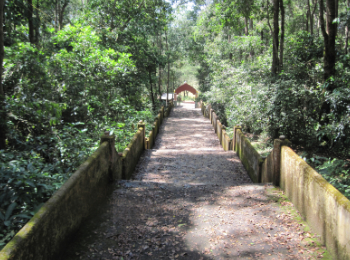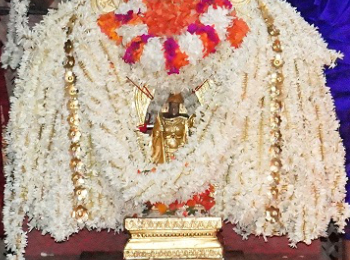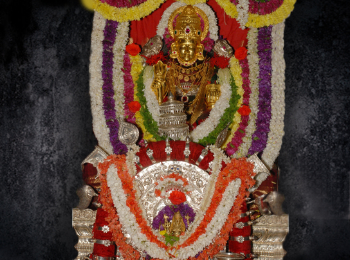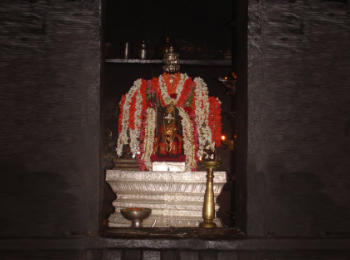- Durga
Durga Parameshwari Temple
- Belmannu,Karnataka
- View on map
- Tell us about this temple
Overview
The Durga Parameshwari temple is a Rakteshwar temple that is located in Belmannu. It is a small village and lies almost exactly midway between Karkala and Padubidri. After turning right on the Mangalore- Udupi highway at Padubidri it is about 12 to 15 kms from Padubidr. It is about 18 kms from Karkala. This temple was constructed in 7th Century A.D.As it is surrounded by greenery and appears as if the temple is located in the middle of a thick jungle and thus, it is popularly known as Vana Durga temple or Durga of the forest. There are many more Rajan Daivas at this temple.
The oldest Kannada copper plate inscription was found under the foundation of this temple in 1952. The inscription states that certain rights were given to the Belmannu Village Council which functioned from the Temple, maybe looked after the operations of the temple. As the inscription dates back to 8th century AD, the temple is believed to be older than the inscription.
About the temple

The Durga Parameshwari temple has a wonderful serenity about itself that is quite unique. The temple structure looks very good and seems like it have been renovated a few years ago. The Prangana of the temple is very huge and is fairly well maintained. The priests of the temple are always from the Bhargava Gotra.
There is a splendorous idol of Lord Ganesh at the right side of the temple which has been newly built. There is no doubt that the Lord who wards off all the hurdles and blesses with all the wishes to the devotees has become significant in the kshetra. He is served with panchakajjaya, appa, paayasa as naivedya and is worshipped with only one arti which indicates his simplicity, and responds to the call of his devotees and has become their favorite one. Earlier there was a dashaavataara yakshagana troupe and along with the troupe there was a silver coating for this Ganaraja where devotees used to worship him.
At the right side of the hall facing the sanctum sanctorum there is a pendal of Kodamanittaaya deity. At the east side of the temple outside, there are shrines of Rakteshwari and Chamundi and also the shrine of Tamburi Naaga. A little far away at the west side is the deity shrine of miraculous deity Dhoomavati (Jamburli). At the outer circle there are magnificent towers. Sanctum sanctorum is quadrangular. Apart from it teertha mantapa in the court yard and enclosing wall are delicately constructed. At the front of the temple the flagstaff is coated with copper. At the top of the flagstaff there is an idol of lion which gives an excellent grandeur.
The tower at the north side of the temple is the main door. There is a broad stone seat on both the sides of the door. As this is the place to sit and sort out the dispute, this place is considered as the sacred one among the devotees. No one has stood against the verdict given from this place. There is a belief that those who go against the verdict have to face the rage of Ullalti. People enter this door with purity of thought and body.
About the Deity

The main deity is Durga Parameshwari. The Durga Parameshwari temple at Belmannu also houses shrines to Lord Ganapathi, Goddess Rakteshwari.
Legend and stories

In this temple one can see the fascinating idol of Devi which gives the feeling of divinity for the viewers. The devotees in and around the village call this Devi as “Ullalti” by custom. Ullalti is a word in Tulu which means mistress or the mother of the whole world in its broad sense. Shree Devi is famous for her affection who looks after her devotes like a mother.
There is a chance to believe as per the saying of the people that this temple is an ancient one. The people of this village are devotees but never had any temple to worship and thus they had to walk for four to five miles to visit any temple. In the East Sanoor, in the West Nandalike, in the South Piliyoor and in the North Nakre of Shiva temple which were renowned for its own significance.
At this age there was a Bahmin family called Jenni. People used to give respect to the members of the family by not calling any of their names but just calling their family names. Thus there was no surprise that the people forgot their actual names. The family of Jenni was the worshipper of goddess Devi. They devote themselves to her. As there wasn’t any temple of Devi nearby, they used to go to Kukkundoor temple to worship Devi all the time. They used to participate in all the festivals and functions that take place in Kukkundoor temple.
But on one of the mahotsav, people ignored the family of Jenny and the festival resumed before their family could come with their hore kaanike. Jenny family was insulted even after they reached the place.
Out of grief the whole Jenny family shed tears. They felt dejected as they stood before Devi with folded hands like pillars. They determined to build the temple of Devi in their own place Kemmannu as while serving with hore kaanike and returned with the same intent.Later he went to Kollur where the Devi is famous for granting the wish of devotees. He went through meditation. He worshipped through various poojas for forty eight days and prayed “Oh mother goddess who is endowed by the name lokapaavane! Have mercy on me!”
One night Devi, who is like a Kamadhenu to her devotees through approving all the wishes of the devotees came in his dream and said “Dear devotee, stop punishing your body. Why all this vratas and worships? What do you want?”
“Mother, I attained peace the day I came to your divine place. But the devotees in our village are suffering from the lack of your presence though they would like to serve and worship you. Therefore I pray you to reside in our village to bless the good people of our village” as soon as he completed his words he held the foot of Devi firmly.
Devi said, “Vatsa, stand up, stop your tapas and return to your place today itself. I will come with you. Believe me. But don’t turn back anywhere on the middle way” and she disappeared.
Janni awoke from his dreams. No one was seen nearby. “I got the darshan of Devi at least in the dreams. And she also promised to fulfill my wish. My tapas yielded fruitful result” and he felt happy. “Mother, I follow your order. Please come with me” and he started from there. It was deeply rooted in his heart that Devi was coming with him. Like an invisible lake of nectar, melodious festive trumpets and the tinkling sound of bracelet and anklet were heard behind. His heart filled with ecstasy as he felt all these was the grace of Devi, and thus he was marching fast towards his village with the intention of establishing his goddess in a place surrounded by water. The festive music became more intense as he was about to reach his destined place. Jenny’s happiness was boundless. Out of excitement Jenny turned back to see his Devi entirely forgetting the warning given by her that he was not supposed to turn back. The sound of festive music stopped instantaneously. The light turned dull. Devi disappeared like a flash.
Jenny felt depraved for his guilt of looking back violating the order given by the goddess. He was inconsolable and he cried like a child for his sin. Looking at the place where goddess had disappeared, Jenny thought whether she decided to establish in that place. He also thought of building a temple in that particular place. Consoling himself by telling that only his devotion could save him, Jenny once again started to Kollur. Those who forget their duty and fall on the earth, they rise once again. In the same way Jenny decided to seek asylum of goddess. “Oh Devi, forgive my sin which was occurred due to ignorance. I am ready to face any punishment given by you for my sin. But please do come to the place which is suitable for the construction of temple. I am determined to bestow everything to you. Please give me the opportunity for it and elevate me. If you don’t listen to my prayer I will sacrifice my life at your feet” he prayed and spent 48 days in meditation.
Devi was touched by the determination of Jenny. A divine utterance was heard which said. “Son, I am pleased by your intense devotion and determination. Go and build a temple for me in the place whichever you find suitable. Make arrangements for its auspicious occasion. I will come at that time and fulfill your prayer.”
A happy Jenny returned to his native and called the people of his village and told his decision. They resumed the work of building temple on an auspicious day. People from in and around the village and devoted themselves to the sacred work of building temple. Sanctum sanctorum, courtyard, temple tower, verandah, sacred pendal were all built swiftly. People felt that that was the blessings of Devi to get more work done in less time and began to praise her by hymns.
Brahmins well versed in Vedas were invited. An auspicious day was decided for the installation. All the arrangements were done. But how could installation happen without the idol? People asked this question to Jenny. This question bothered even Jenny as he relied on Devi. Without losing heart he suddenly made an arrangement by appointing an eligible sculptor to sculpt the idol of Devi in black stone. By following all the tradition of jala, dhaanya installation work was done at the auspicious time. Navagraha homa and such customs were followed. During kumbakalashabhisheka and festive music, at the north side of the idol, linga came up breaking the earth. She was jagajjanani in the form of linga. People were spell bounded by this spectacular outcome.
Tulu speaking people named her as Ullalti which means mistress to the universe. Janni devoted himself entirely for the remaining works of the temple. Priests were appointed for pooja everyday three times; Shantis for performing naivedya and such other rituals; Upadhis, Devakaris, Patalis, Devadigas, Madivals, Kubars, Vishwakarmas, Gudigas, Paravas were appointed for performing Durga sahasranama, SaptaShatee, Pavamana. To undergo uninterrupted ritual throughout free lands were granted for the concerned people and thus Janni became immortal.
A saying says “Kalaanudurgaavinaayaka” which means that in Kaliyuga, the Lord Vinayaka and Goddess Devi would bless the devotees quickly for their little service which is true in the case of this holy place where devotees were graced with ample benefits. Today we don’t find any trace of the place where Jenny and his family lived. But still the story might not be just a myth about the establishment of temple by Jenny. In the ancient times there were many kings, charitable people, poets, scholars who had done many good deeds for the society without any expectation of getting name and fame. Shree Jenny also belongs to such category. The belief is that he devoted everything for the establishment of the temple and he went to pilgrimages with his family. It is a sign of gratitude shown by the people from generation to generation that they have not forgotten the service given by Jenni.
Arti/Pooja/seva
At the proximity of Devi pooja is performed three times a day including early morning, afternoon and in the evening. In the morning nirmaalya visarjane pooja and usha pooja in the afternoon panchaamrata, kalasha, vasanta pooja and ekaanta seve with festive music. A lamp is burned always and everyday naivedya is served and during sankranti, navaraatri and such auspicious days meal is served.
Festivals
On the day of Chaitra Shuddha Paadya, mahaa ranga pooja and vasatha pooja during the month of Mesha worship is done with great ceremony. Rudraabhisheka, and during Chouti, gana homa worship occurs. During Nava Raatri, kalpokta pooja and such worships are performed with great splendor. During the month of Makara celebration occurs for nine days with festive sacrifice. On the day of Kumbha Sankramana flag is hoisted and six days of annual festival occurs where people from in and around the village participate and provide financial aid to make the event successful by grand celebration. During these times worships of Brahmins and married women (who is not a widow) occur, vimaanotsav, the annual car festival occur by pulling the chariot on the side of north and south with utmost faith and devotion. Meal is served to all on the day of annual car festival. In this manner, from time to time all the rituals have been followed according to vedic ritual and thus this is received by Shree Devi with all pleasure and blesses the requirements of devotees.
Accessibility
The Mangalore International Airport is the nearest route by air, while Udupi houses the nearest railway station. One may reach Belmannu from Bangalore via Nelamangala on the Hassan - Sakaleshpura - BC Road - Kateel – Mundkur, or from Mysore via Hunsur - Kushalanagar - Madikeri - Sulya - Puttur - BC Road - Kateel – Mundkur.
Address
Belmannu Sri Durga Parameshwari Temple,
Belmannu Village,
Padubidri - Karkala Road,
Karkala Taluk,
Udupi District,
Karnataka
Significance
Devotees visit this temple to seek fulfillment of the following:-
- Trouble-free marital life
- Removal of physical ailments
- Freedom from economic Problems
- Fearless disposition
Shlokas
Ayi Giri Nandini Nandita Medini Vishva Vinodini Nandi Nute Giri Vara Vindhya Shiro Adhi Nivaasini Vissnnu Vilaasini Jissnnu Nute Bhagavati He Shiti Kannttha Kuttumbini Bhuri Kuttumbini Bhuri Krte Jaya Jaya He Mahissaasura Mardini Ramya Kapardini Shaila Sute
Meaning -I offer my salutations to the mountain's daughter, who fills the world with joy, who is praised by Nandi, who lives on Vindhya's summits, who gives joy to Her brother Lord Vishnu and who Lord Indra praises, Oh Goddess who is Lord Shiva's consort and who created abundance. The destroyer of the demon Mahishasura, the one with beautiful hair and the mountain's daughter, victory to you.
Madhu Kaittabha Vidhvamsi Vidhaatr Varade Namah Ruupam Dehi Jayam Dehi Yasho Dehi Dvisso Jahi
Meaning -Oh Devi Durga, we salute you for destroying Madhu and Kaitabha and granting Lord Brahma the boon of protection. Please bestow on me spiritual beauty, victory and glory and crush my inner enemies.
Mahissaasura Nirnaashi Bhaktaanaam Sukhade Namah Ruupam Dehi Jayam Dehi Yasho Dehi Dvisso Jahi
Meaning -We salute Goddess Durga who destroyed Mahishasura, the demon, who bestows a lot of happiness on Her devotees. Please bestow on me spiritual beauty, victory and glory and crush my inner enemies.
Dhuumranetra Vadhe Devi Dharma Kaama Artha Daayini Ruupam Dehi Jayam Dehi Yasho Dehi Dvisso Jahi
Meaning -I offer my salutations to Durga Devi, who killed Dhumranetra, the demon, I offer my salutations to the giver of dharma, kama and artha to Her devotees. Please bestow on me spiritual beauty, victory and glory and crush my inner enemies.
